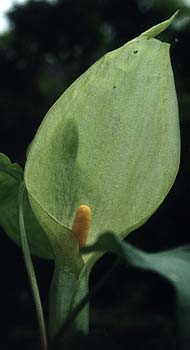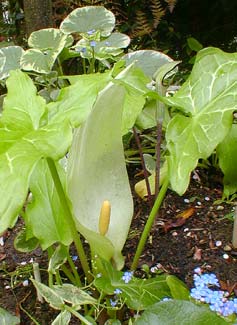
Italian Lords-&-Ladies;
or, Large Cuckoo's Pint;
or, Marbled Arum;
or, the Willy Lily;
or, Aaron's Pen (Aronskelk);
or, Aaron's Staff (Aronstab)
"When sweet wild April
Dipped down the dale,
Pale cuckoopint brightened,
And windflower trail."
-William Force Stead
(1884-1945)
(1884-1945)
At top is a mid-June photograph of the green spathe & yellow spadix of Mottled Italian Lords-&-Ladies (Arum italicum ssp italicum var marmoratum). Its second year in the garden it bloomed in May, as shown in the second photo with some 'Hadspen Cream' Brunnera visible behind it, & the Brunnera's wee blue flowers to the right.
This is the most commonly offered variety & frequently sold with the cultivation name 'Pictum' or increasingly with the variant name 'Marmoratum.' Occasionally one sees 'Pictum' & 'Marmoratum' in a single catalog as though they are distinct cultivars, but they are not, though there can be considerable variation in the mottling from plant to plant & from one grower's strain to the next, so that it may not be entirely dissengenious to list them as different.
"Italian Lord-&-Ladies" seems to be its most common name in English, & presumedly alludes to the flower as resembling some sort of excessive court costume. Many folk-names for arums assume the spathe is a vagina & the spadix a phallus, & it seems that Lords-&-Ladies & less often used variants like Lady-Lords & Kings-&-Queens, & even the folk-name Adam-&-Eve, all regard this common assumption. Even so, some Christian mythographers have suggested the name was once Our-Lady-&-Our-Lord, with the spathe emblematic of Mary's cloak as she leans over her infant, the spadix. Several similar-looking lilies have been used iconographically with exactly this meaning.
 It is also called "Large Cuckoopint" or "Cuckoo's Pint." Pint is a contraction of Pintle, a bolt or pin, but originally meaning a penis. For the same obvious reason of the spadix's phallic appearance, the plant has been known by a number of vulgarly whimsical names: Willy Lily, Dog's Dilly, Dog's Dibble, Priest's Pilly, or Priest's Pintle. Very likely the folk-name Parson-&-Clerk is an intentionally homosexual play off Jack-in-the-Pulpit.
It is also called "Large Cuckoopint" or "Cuckoo's Pint." Pint is a contraction of Pintle, a bolt or pin, but originally meaning a penis. For the same obvious reason of the spadix's phallic appearance, the plant has been known by a number of vulgarly whimsical names: Willy Lily, Dog's Dilly, Dog's Dibble, Priest's Pilly, or Priest's Pintle. Very likely the folk-name Parson-&-Clerk is an intentionally homosexual play off Jack-in-the-Pulpit.In the UK arums are occasionally called Jack-in-the-Pulpit (sometimes ammended to Parson-in-the-Pulpit), though elsewhere this name would be given only to the similarly-flowered cobra lilies of the Arisaema genus. European settlers in North America called Arisaema triphyllum the "three-leafed arum" & adapted many European Arum names to the American Jack-in-the-Pulpit, as well as occasionally to Trilliums. Some of these miscellaneous names for Arums, most now rarely used, include Ramp, Quaker (viewing the spathe as a quaker's bonnet), Bobbins or Golden Wake Robbin, Adder's Root, Calf's Foot, British Arrowroot, or Starchwort, this last because the root, if beaten & cooked, loses its toxicity & is an acceptable starchy food.
Arums have further been known as Janus's Plant or Yanos, & are still so-called in some Romance nations. Janus was the Roman god of Watchfulness, Gates, & of Beginnings & Ends, who stands vigilant at the doorway to heaven. In the morning light, the spathe indeed seems to glow from within, as though it might indeed be the gate of heaven, with Janus standing guard.
In sundry places in Europe the species is also known as Aaron's Herb (Hierba de Aaron), Aaron's Staff (de staff von Aaron, or Aronstab), or Aaron's Pen or Chalice (Aronskelk). There is an antiquated English name, Barba-Aron, meaning "Aaron's Beard," although this is now the usual name for Hypericum calycinum, because the yellow flowers have furry beard-like centers.
"Aronskelk" is the name that most greatly interested me. Kelk can mean "chalice" to the Dutch & in some related languages, & so alludes to the large spathe, but it also indicates something to write with, either "chalk" with which "kelk" is homonymous, or an old-fashioned "nibbed pen." This is due to the spadix resembling a writing utensil. Why this would in particular be the staff, chalice, or pen of the brother of Moses & Miriam may evade most people, but in Farci the kelk takes on a deeper meaning of a mystic's pen, used for sacred calligraphy, such as might indeed have been Aaron's.
If construed as "Aaron's Chalice," this can be illuminated by a certain Arabic legend. When Moses first went forth from Egypt, Aaron became Pharaoh's vizier. On the day that Moses was returning to Egypt armed with the Lord's authority, an angel came to greet Aaron. This angel bore a crystal cup of wine, saying, "Drink, Aaron, of the Lord's avenging vintage, given you with glad tidings, for your brother has been chosen as His Prophet, & you are from this day forth no longer Pharaoh's vizier, but the Lord's." And Aaron drank deep of the crystal cup, & gave thanks to the Lord, & went forth to join his brother.
A similar cup was presented from the Lord to Jeremiah [Jr 25:17], when once again the wine it contained was a wine of wrath. When Israelites drink of this cup, it is pure water, or good wine, but when Pharaoh attempted to drink from the same cup as Aaron & Moses, it held for him only bitterness & blood. This crystal cup was later coopted in Christian myth as the Holy Grail [Lk 22:20], brought to England by Joseph of Arimathea to enter into the lore of Camelot.
It is as Aaron's Pen that legend poors forth from this Arum. A midrash about the plagues that were brought to Egypt plays off the biblical puns devar which means "word" & dever which means "plague." Moses borrowed Aaron's Pen with which to draw mystic letters in the air which brought about each plague.
Another midrash speaks of Mose while using Aaron's Pen to write the Five Books dictated by G-d. After six chapters of Leviticus, Moses noticed that Aaron's descendants were often mentioned, but Aaron as a person was not mentioned even once. This stung the gentle heart of Moses who loved his brother. He spoke to the Shekhinah, saying, "You hate my brother because he was not brave enough to deny a mob the Golden Calf, but you love his descendants & make them your priestly class." Upon this censorious observation, the Shekhinah relented.
When the great work was finished, Moses wiped sweat from his forehead with Aaron's Pen still clutched in his fingers, accidentally staining a forelock with the mystic ink that had never needed to be replenished throughout the labor. And the stain upon his forelock caused Mose's face to shine with a heavenly light for the rest of his life, so bright he would go in public with a veil lest he blinded who gazed upon him.
Meanwhile, the pen was returned to Aaron & passed down through his descendants, who used it to make perfect copies of Torah.
The traditional Jewish method to test a new pen is to write the name of Amalek who was the slayer of Jews in the wilderness, then cross out that name. If the pen proves itself good enough for this sacred act, it is good enough for anything. The first time the name of Amalek was ever so expunged was with Aaron's Pen. Joshua was able to defeat the nation of Amalek only after Moses lifted up his arms heaven. When his arms weakened, Hur stood on one side of him, Aaron on the other, & they braced his arms for the duration of the battle to insure Joshua's victory [Ex 17:8-13].
Although Amalek was destroyed, it was at great cost of suffering, & the evil spirits continued to pollute the world, inspiring demonic antisemitism for all the millenia since. For this reason was there a regulation that the name of Amalek be scribbled out [Ex 17:14; Dt 25:19]. Down to our own age, any pen used for the sake of this commandment is Aaron's Pen.
The name Aronstab ("Aaron's Staff") is from the more widely recollected story of Moses turning Aaron's staff into a serpent in Pharaoh's court. In the wilderness, this staff was planted in the Tent of Meeting, where it grew into an almond tree [Nm 17:5-8]. Presumedly the tree withdrew back into the form of a staff when it was time to move the Tabernackle, & Moses often bore Aaron's staff, as when he used it to draw water from a rock called Miriam's Well. To English-speaking gardeners, these legends of the staff would be associated with the common mullein, Verbascum thapsus called Aaron's Rod.
But to return to practicalities. Usually by late spring or early summer, Arum leaves will be wilting away, & the spathe will have dried & folded back from the spike, which from the female flowers will be developing large berry-like seeds. The dying leaves can be clipped off, but take care not harm the spike of berries which will be some while ripening, turning from a shiny green in summer to a highly decorative bright orange-red in autumn.
In late autumn or early winter, the leaves re-emerge. For 'Pictum,' in our garden at least, the leaves are only just beginning to show themselves toward late October, are still small in November, & finally beginning to flourish in late December or in January, truly a winter plant. But we have a plain-leafed Lords-&-Ladies (A. italicum ssp albiospathum) planted further back in the garden, & another marmoratum variant with the cultivar name 'Silver Shield.' These get good & leafy by Autumn's end, while 'Pictum' only gets good & leafy late in winter, & in fact does not achieve its leafiest state until ready to bloom in spring. Many gardeners like to plant arums with hostas, as about the time the large hosta leaves are dying back in autumn, Lords & Ladies' arrowhead leaves are getting ready to emerge; but we've found 'Pictum' to be rather late to be the best for this purpose, though both 'Albispathum' & 'Silver Shield' do meet that need.
'Pictum' has a shorter stature & smaller leaves than 'Albiospathum,' & its leaves are wonderfully mottled & veined with silvery white. The leaves are more elongated than on the suspecies albiospathum, & it is much more restrained than albiospathum which will spread rapidly given the right conditions.
Some specimens that look like 'Pictum' have broader leaves. These are intraspecies hybrids, as any of the subspecies or variants planted in proximity will cross-pollinate. In just the last decade newer named cultivars have been developed preserving the patterned leaves in strains with distinguishing traits.
The large arrow-shaped leaves grow up to two feet in sweep & easily a foot tall. This spectacular foliage lasts all winter & continues through most of spring.
Both flower photos show the flowers of 'Pictum,' with the second photo showing also the mottled leaves, as well as some blue flowers from creme-edged leaves from the Brunnara. I've also seen a spotted form offered for sale as "Spotted Jack," the dark green leaves having brown pokadots. I fear my first impression of that one was that it looked merely diseased, so I did not add that one to the shade garden, though perhaps if I see it offered often enough to get used to it, I'll bring one home someday.